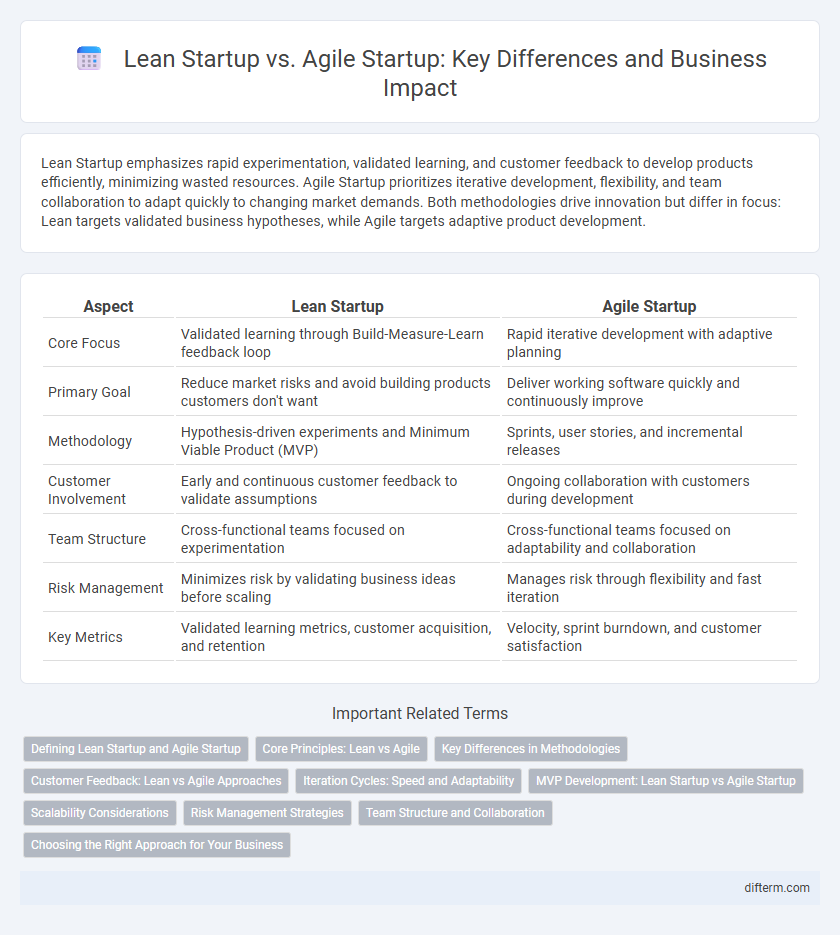Lean Startup emphasizes rapid experimentation, validated learning, and customer feedback to develop products efficiently, minimizing wasted resources. Agile Startup prioritizes iterative development, flexibility, and team collaboration to adapt quickly to changing market demands. Both methodologies drive innovation but differ in focus: Lean targets validated business hypotheses, while Agile targets adaptive product development.
Table of Comparison
| Aspect | Lean Startup | Agile Startup |
|---|---|---|
| Core Focus | Validated learning through Build-Measure-Learn feedback loop | Rapid iterative development with adaptive planning |
| Primary Goal | Reduce market risks and avoid building products customers don't want | Deliver working software quickly and continuously improve |
| Methodology | Hypothesis-driven experiments and Minimum Viable Product (MVP) | Sprints, user stories, and incremental releases |
| Customer Involvement | Early and continuous customer feedback to validate assumptions | Ongoing collaboration with customers during development |
| Team Structure | Cross-functional teams focused on experimentation | Cross-functional teams focused on adaptability and collaboration |
| Risk Management | Minimizes risk by validating business ideas before scaling | Manages risk through flexibility and fast iteration |
| Key Metrics | Validated learning metrics, customer acquisition, and retention | Velocity, sprint burndown, and customer satisfaction |
Defining Lean Startup and Agile Startup
Lean Startup is a methodology centered on iterative product development, validated learning, and rapid experimentation to minimize waste and optimize market fit. Agile Startup emphasizes flexible project management, continuous delivery, and customer collaboration to adapt swiftly to changing requirements and enhance product quality. Both approaches prioritize responsiveness and efficiency but differ in their core frameworks and execution strategies within the startup ecosystem.
Core Principles: Lean vs Agile
Lean Startup emphasizes validated learning, rapid experimentation, and minimizing waste by building a minimum viable product (MVP) to quickly test assumptions and adapt based on customer feedback. Agile Startup centers on iterative development, flexibility, and continuous improvement through collaborative teams and frequent delivery of functional product increments. Both methodologies prioritize customer-centric innovation but differ in their approach to managing uncertainty and product development cycles.
Key Differences in Methodologies
Lean Startup emphasizes rapid hypothesis testing and validated learning to minimize wasted resources, focusing on building a minimum viable product (MVP) to quickly gather customer feedback. Agile Startup prioritizes iterative development with evolving requirements, stressing collaboration and flexibility within cross-functional teams to respond swiftly to change. Key differences include Lean's focus on experimentation and market validation versus Agile's emphasis on adaptability and continuous delivery throughout the development cycle.
Customer Feedback: Lean vs Agile Approaches
Lean Startup emphasizes rapid customer feedback through minimum viable products (MVPs) to validate hypotheses and pivot quickly based on real user data. Agile Startup integrates continuous customer feedback within iterative development cycles, fostering adaptability and ongoing improvement throughout the product lifecycle. Both frameworks prioritize customer insight but differ in timing and method of incorporating feedback for business growth.
Iteration Cycles: Speed and Adaptability
Lean Startup emphasizes rapid iteration cycles to quickly validate hypotheses through Minimum Viable Products (MVPs), enabling fast learning and pivot decisions. Agile Startup prioritizes adaptable development sprints that continuously integrate customer feedback, enhancing flexibility in product evolution. Both methodologies accelerate time-to-market but differ in focus: Lean Startup targets hypothesis testing speed, while Agile Startup ensures ongoing adaptability through iterative refinement.
MVP Development: Lean Startup vs Agile Startup
Lean Startup emphasizes building a Minimum Viable Product (MVP) quickly to test hypotheses and gather validated learning from early customers, minimizing waste. Agile Startup focuses on iterative development cycles, continuously improving the MVP through customer feedback and adaptive planning to enhance product-market fit. Both methodologies prioritize MVP development but differ in speed and flexibility, with Lean Startup aiming for rapid validation and Agile Startup for ongoing refinement.
Scalability Considerations
Lean Startup methodology emphasizes validated learning and iterative product development to minimize waste and ensure market fit before scaling, making it ideal for startups seeking efficient resource allocation. Agile Startup prioritizes flexibility and rapid response to change through continuous delivery and customer feedback, supporting scalability by enabling teams to adapt quickly as the business grows. Scalability considerations in Lean focus on refining a scalable business model, while Agile supports scaling operational processes and team structures dynamically.
Risk Management Strategies
Lean Startup emphasizes rapid experimentation and validated learning to minimize market risks by iteratively testing hypotheses and pivoting based on customer feedback. Agile Startup focuses on flexible project management and continuous delivery, reducing operational risks through adaptive planning and incremental progress. Both methodologies integrate risk management by promoting early failure detection and responsive adjustments to changing business conditions.
Team Structure and Collaboration
Lean Startup emphasizes small, cross-functional teams working iteratively to validate hypotheses with rapid feedback loops, fostering a culture of experimentation and minimal viable product development. Agile Startup prioritizes flexible collaboration through sprint-based workflows and continuous improvement within self-organizing teams, enhancing adaptability to change and customer responsiveness. Both methodologies optimize team dynamics for innovation but differ in structuring collaboration around validated learning versus iterative delivery cycles.
Choosing the Right Approach for Your Business
Selecting between Lean Startup and Agile Startup methodologies depends on your business goals and operational needs. Lean Startup emphasizes validated learning, rapid experimentation, and customer feedback to minimize market risks and avoid building unwanted products. Agile Startup focuses on iterative development, flexibility, and collaboration to quickly adapt to changing market demands and accelerate product delivery.
Lean Startup vs Agile Startup Infographic

 difterm.com
difterm.com